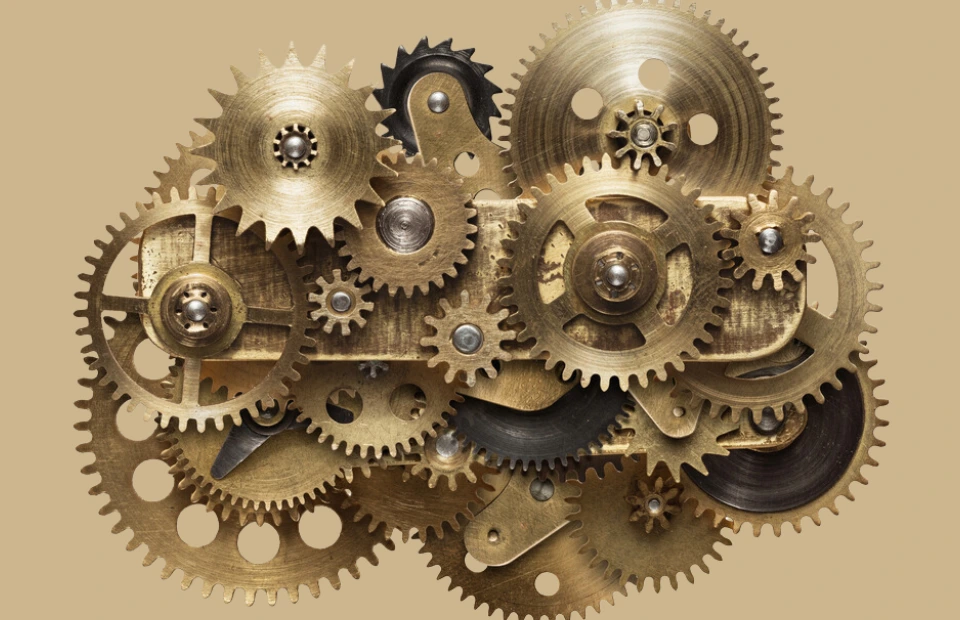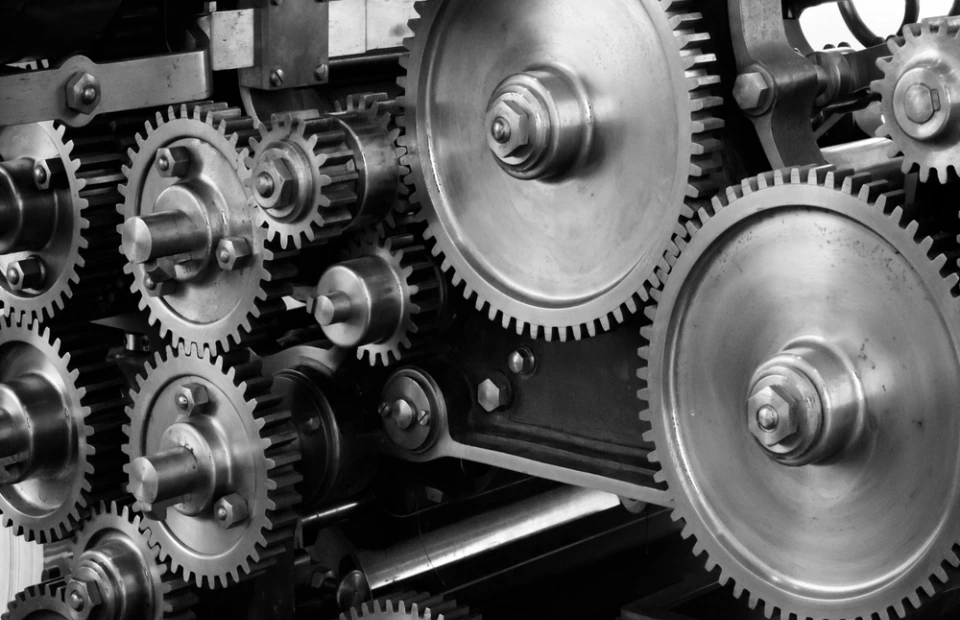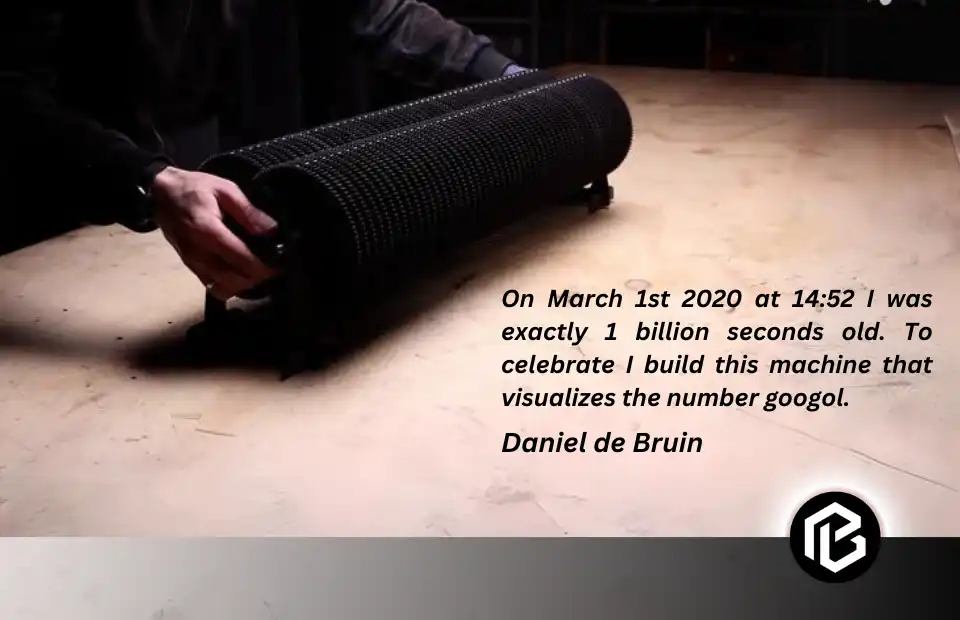In March 2020, Daniel de Bruin, a Dutch designer, built a machine with 100 gears to celebrate being alive for one billion seconds.
Using Legos, a maker created an extreme gear reduction machine.
The gear ratio of the machine is close to GOOGOL: 1.
Googol Gear Machine? A system of gear reductions organizes the machine’s 186 Lego gears. To turn the first gear, a Lego motor is used. Do not wait for the last gear to turn; it is holding a statue of a Lego minifig.
Gear Ratio
The precise gear ratio of the apparatus, expressed in decimal form:
103417963084873348009928328042228851047736114984999976960000000000000000000000000000000000:1 = 1
The language of science:
1.0342 x 10⁴= 1
This ratio is very close to becoming 10100, the size of a googol. A ridiculously large sum. As a point of contrast, only around 10,800.000 atoms are thought to exist in the cosmos.

How Does the Machine Work?
Let’s begin from the beginning and methodically move through the equipment. To begin, the device uses a Lego motor that is driven by a Lego battery box. An 8-tooth Lego gear and a 24-tooth Lego gear are meshing with the motor. Here we have a straightforward gear reduction pair.
The mechanical advantage of a gear reduction pair allows for the amplification of torque about rotational speed. Although it rotates at a slower rate, the second gear will apply greater force.
The gear ratio, which measures the mechanical advantage, is determined by the number of teeth on each gear. Two gears, one with eight teeth and the other with twenty-four, are meshing here. The ratio of the gears is 3 (24/8). According to the ratio, the bigger gear produces three times the torque with three times the speed of rotation.
This trade-off is second nature to anyone who has driven a vehicle equipped with a manual transmission. In first gear, you have the necessary torque to begin moving the car from a standstill, but you won’t be able to go very fast. Putting the car in fifth gear gives you plenty of speed for interstate driving, but not enough torque to get it moving from a stop (or otherwise the engine will stall).
The second set of gears is then added in series with the first set. To accomplish this, you’ll need to share an axle with both the first set’s output gear and the second set’s input gear. The second set of gears has a 40-tooth gear and an 8-tooth gear. The gear ratio, which measures the mechanical advantage, is determined by the number of teeth on each gear. Two gears, one with eight teeth and the other with twenty-four, are meshing here. The ratio of the gears is 3 (24/8). According to the ratio, the bigger gear produces three times the torque with three times the speed of rotation.

This trade-off is second nature to anyone who has driven a vehicle equipped with a manual transmission. In first gear, you have the necessary torque to begin moving the car from a standstill, but you won’t be able to go very fast. Putting the car in fifth gear gives you plenty of speed for interstate driving, but not enough torque to get it moving from a stop (or otherwise the engine will stall).
The second set of gears is then added in series with the first set. To accomplish this, you’ll need to share an axle with both the first set’s output gear and the second set’s input gear. Two gear sets, one with eight teeth and the other with forty teeth, make up the second set.
The compound gear ratio can be determined by multiplying the separate gear ratios. There are two sets of gears in this gear train, with ratios of 3 and 5. The sum of the gear ratios is 15 calculated as 3*5.
The gear reduction mechanism is built upon this. Just a succession of several gear pairs. The overall gear ratio grows exponentially as the number of gear pairs increases. To achieve a big gear ratio, it is necessary to employ tiny input gears and large output gears in each pair. This process must be repeated for an adequate amount of time.
The series is now expanded with two further sets of gears, one with 8 teeth and the other with 40 teeth. There is a total gear ratio of 375.
The initial worm gear follows. For getting a lot of gear reductions, worm gears are the way to go. The follower gear will only move one tooth when the worm gear is turned 360 degrees. The mechanically identical worm gear is known as a one-tooth gear.
One Lego turntable has sixty teeth, and it’s driven by worm gear. Following that, the rotational movement is assisted by two 12-tooth bevel gears that are used in an L-turn configuration. They are in perfect mechanical harmony due to their identical tooth count, which forms a 1:1 ratio. Finally, there’s a 12-tooth gear coupled with a worm gear.
Why employ such intricate gear combinations is something you might ask. Just so you can see how the rotation slows down, we’re building a clock. At 375 RPM, the Lego motor spins. With a ratio of 375 for the first gear block, the output will decrease to precisely one revolution per minute. A clock will stand in for the second hand. The minute hand is represented by the output of the gear ratio 60, which is the next gear ratio. Finally, the hour hand, which rotates once every twelve hours, is symbolized by the gear ratio of twelve, which slows down the movement. See the time ticking away right here.
The Hailfire Droid Wheel, the biggest piece of Lego gear ever made, is up next. On the inside, it features an incredible 168 teeth. A short worm gear drives it. A belt drive, made of a white rubber band, is utilized to transmit rotation on the worm gear. Another possible mechanical benefit of belt drives is that they don’t alter the total gear ratio—the two shafts that are connected to the belt have the same radius as a Lego bush, so the gearing is 1:1.
The following one is the most involved of the bunch; it’s a 2608.5 ratio planetary gear arrangement. This video which does a good job of explaining the premise is where I got the idea. You need to line up two inner gear rings—the yellow ones made of curved Lego gear racks—with slightly different tooth counts; this will keep the mechanism running smoothly. Both yellow rings have a different number of teeth; one has 140 and the other 141. A tiny space was created between the yellow Lego gear racks to achieve this effect (refer to this source). The result is that the planet gears will push the bigger yellow ring one tooth forward every time the carrier, which links the sun and planet gears, turns one rotation. Gear reduction will be high as a result of this. To see it in action, click here.
We can now move on to taking advantage of the exponential growth by switching to brute force mode since we have covered imaginative builds.
Twenty consecutive pairs of basic 8-tooth and 40-tooth gears are used initially. A gear ratio of 520 is the result. A 12-tooth L-turn and a 20-tooth L-turn follow this series. The sum of all gear ratios is 264909532335069.4, or 2.6 * 1014 in decimal form.
A set of worm gears that drive 24-tooth gears follows. Twenty gear pairs make up the series. A Lego gearbox is a see-through container that houses the gears. In decimal notation, the total gear ratio for this unit is 4019988717840603673710821376, which is equal to 4.0 * 1027.
Chains also allow you to make gear ratios. Attached to this Lego link chain is a turntable with 56 teeth and a gear with 16 teeth. Following that, there are ten sets of 36-tooth gears with worm gears. A total of 12796554540220416, or 1.3 * 1016, is the gear ratio of this device.
After that, there’s a machine unit with the maximum ratio. There are 18 sets of gears, each with 40 teeth, and worm gears. At 6.9 * 1028, or 68719476736000000000000000, we have the gear ratio.
The final component has a low ratio. The goal is to get the total gear ratio as near to googol as possible while moving the statue. It makes use of a 9-toothed and a 15-toothed Lego Expert Builder gear from the 1970s. The figure of a Lego minifig is displayed on a Lego turntable that is powered by a worm gear. Just 93.3 is the gear ratio.
That was the last step. As a whole, the gear reduction series has a compound gear ratio of about GOOGOL:1. From high above, here is a picture of the device.
How does it Operate?
Turning on the Googol Gear Machine causes the motor to begin spinning rapidly. This is at 375 RPM, which is lower than the motor’s no-load speed of 400 RPM. As a result, the gear train offers minimal resistance.
Fast rotation is produced by the first gear reduction pair. The second set spins at a slightly slower pace, while the third set spins at an even slower pace. At the sixth gear pair (the minute hand), there is no longer any discernible, instantaneous progress. Once the sixth set of gears is engaged, all subsequent gears will remain stationary. It’s pretty dull.
The output of the planetary gear might shift slightly if you waited a lifetime. Once every 600 years, it turns around. In theory, the machine’s last gear—the minifig statue—will move at an absurdly slow speed while producing an absurdly large torque.
Each gear, axle, and supporting structure has its physical limitations when it comes to the amount of torque and stress they can endure. Placing the final gear in a block of concrete to prevent it from turning might cause something to shatter. However, there is just not enough time to test it.
Unless you stop the final gear from rotating, the machine will keep operating indefinitely. Googol Gear Machine is an example of this. The last gear can spin freely, however, it can only turn the minifigure statue. So, this machine may keep going indefinitely. Once more, abstractly.
Additional time-related constraints exist in actual use. Repeated use would eventually cause the motor and axles to break down. For instance, the Earth would collide with the Sun due to the extremely long time scales. The last gear could never be seen by anyone.
Math
Each gear unit’s gear ratio was planned and evaluated in Excel.
Due to Excel’s tendency to generate rounding errors, a Casio Online calculator was employed to precisely assess the final gear ratio and rotation duration.
When all gears are engaged:
103417963084873348009928328042228851047736114984999976960000000000000000000000000000000000:1 = 1
equal to 1.0342e100:1.
Duration of rotation for the final gear:
the number of years 52433879932503535381614991275498187972589101825233846406570841889117043121149897330595482546
that is, 5.2434e91 years
Total gear ratio formula:
The given equation can be paraphrased as follows: “The input values are 24/8, 40/8, 40/8, 60/1, 12/1, 168/1, (140 / 8 + 1) * 141, 20/12 * (40/8)^20 * 20/12 * (24/1)^20 * 56/16 * (36/1)^10 * (40/1)^18 * 15/9 * 56/1.”
How Long is 5.2 x 1091 Years?
In 5.2 * 1091 years, the statue will make one full rotation. Though it’s still incredibly huge, that figure is marginally less than a googol (10100). Given that almost all physical objects in the universe would cease to exist long before the statue even begins to turn, calling it an astronomical quantity would be a bit of an understatement.
- The product of one year and one hundred is one year.
- The typical human lifetime is 7.5 times 101.
- Since the evolution of Homo sapiens
- Earth’s gravitational pull toward the Sun is 7.6 * 109
- The universe’s age is equal to 1.4 * 10^10.
- The vast majority of star objects have already collided with black holes.
- The Googol Gear Machine completes its initial revolution at 5.2 * 1091.
- All black holes have disintegrated due to Hawking radiation, which is equal to 1.0 * 10106. The universe is devoid of any material objects.
List of Lego Gears Used in the Machine
Number of gears: 186

- 27 x 8 teeth gear 3647
- 12 Tooth Bevel Gear 6x 6589
- Double bevel gear with 12 teeth, model 32270
- gear 94925, one 16-tooth gear
- 2x 20-tooth bevel gear 32198
- 24 Tooth 23x Gear 3648
- 32498, a 10x gear with 36 teeth and a double bevel
- 40 Tooth Gear 49x 3649
- Large Type 2 2x Turntable with 56 Tooths 48452cx1
- One 18939c01 turntable, large type 3, 60 teeth
- 8-Piece Curved Gear Rack with 35 Tooths, 11 by 11 Inch 24121
- 44556 168 Tooth Hailfire Droid Wheel 1x Gear
- Item 27938 is a single-gear worm screw.
- Length 4716, 51-piece gear worm screw
- 9-Tooth G9 Gear Expert Builder, one (1)
- 15-Tooth G15 Gear Expert Builder, one (1)
Similar Machines
Lots of people have made machines that are very much like this. Machine with Concrete, by Arthur Ganson, is a well-liked example. The final gear in this mechanism is set to spin every two trillion years and is now housed in a block of concrete. This machine has a gear ratio of 2.4 * 1020.
Daniel de Bruin also provided an example. This machine’s gear ratio is precisely one GOOGOL, which is accomplished by one hundred gear pairs, each of which produces a ten-to-one ratio.
Frequently Asked Questions on Google Gear Machine
What would happen if you turned the last gear?
A gear ratio of 1:GOOGOL would be yours. The optimal performance for this inverse machine would be to produce extremely high speeds with negligible torque. It is ineffective. The inability of the engine to overcome the machine's friction causes it to stall. The gears won't budge. This video shows the demonstration I gave.
Is it possible for this device to halt the Earth's rotation?
Take a look. A torque of 0.125 Nm is produced by the Lego motor. The output torque of the machine is thus around 1099 Nm. A spinning item, on the other hand, possesses only rotational energy and inertia; it lacks torque. So far as this site can tell, Earth has a moment of inertia of 8.04×1037 kgm2. A force of 1099 Newton-meters torque applied to Earth would result in an angular acceleration of 1061 degrees per second squared. In about ten to sixty-seven seconds, you may go from one revolution per hour to zero. Without delay, Earth's rotation would come to a halt.
However, the torque would need to be applied for the entire amount of time the Earth can spin before coming to a stop. Not at all. Despite the machine's enormous torque output, it's only applicable to extremely minute angle adjustments. You have to put forth some effort to stop an object's rotation. Hooking up the machine's output to Earth would cause the Lego motor to spin backwards at an outrageously rapid speed as it slowly tried to resist.
How much time would be required? This source states that the Earth's rotational energy is 2.138×1029 J. Lego motor mechanical power output is load dependent, but this source claims it is 0.7 W. At such a rate, Earth's rotation would continue for another 1022 years. When compared, less than 1010 years will pass before Earth collides with the Sun.
Can severe gear reductions be put to any good use?
Not that I'm aware of any. I would say no.
Does the statue's rotation occur in tiny increments daily?
No. For the statue to start turning, backlash, which are tiny spaces between gears, would have to catch up for an extremely lengthy period. Static friction would then make it impossible to rotate smoothly. Ignoring those concerns, we find that the potential distance the monument would travel in one second is somewhere between ten and one hundred meters. The Planck Length, on the other hand, is smaller at 1.6 * 10−35 meters. It is believed to be the shortest distance that can be measured physically. Here we reach basic concerns regarding the small-scale operation of the cosmos. The universe might not let the statue spin at the speed of light.
In principle, is it possible to construct a gear reduction machine that is infinitely long?
I think so. It would result in a reduction of gears that would never end. Infinite torque would be provided by the last gear, which would never move.
The last gear won't be able to turn until friction becomes too great for the motor.
No. No amount of friction can ever put a stop to a motor. Probably the concept that has you scratching your head is an infinite series. You reason that since adding more gears increases the system's friction, adding more friction will lead to an unlimited quantity of friction. With infinite friction, no motor can achieve any speed. The reduction of gears is something you failed to take into account. Viewed through the eyes of the motor, the first gear combination will be perceived as necessitating n torque to overcome the friction. Due to its position behind the 3:1 gear reduction, the second pair only needs 1/3 of the torque. Three need n/15, four need n/75, and the rest follows. As we continue, the motor will have an easier time driving the additional gear pairs. If this keeps going indefinitely, it will eventually hit a finite limit, just like a mathematical convergent series. You can keep on going with the gear train indefinitely if that limit is less than the motor's maximum torque, like in this Googol Gear Machine.
Please be aware that this is just relevant to machines that reduce gears. You can't go on indefinitely due to friction if your machine doesn't have any reduction, like a 1:1 gear train. I reached a limit of 111 Lego gears while testing a 1:1 gear train in one of my movies. View the experiment on this page.





